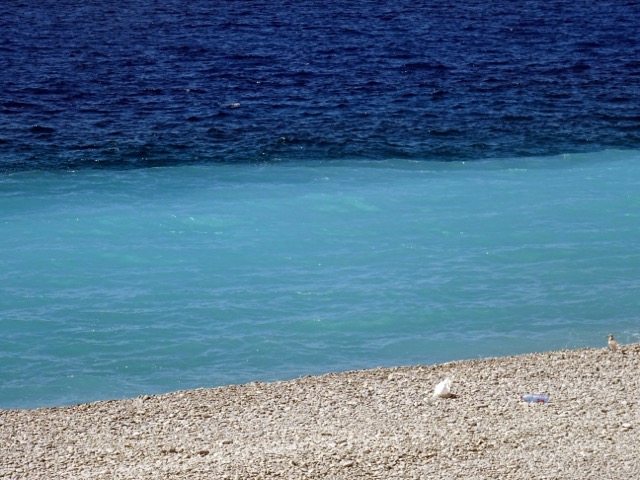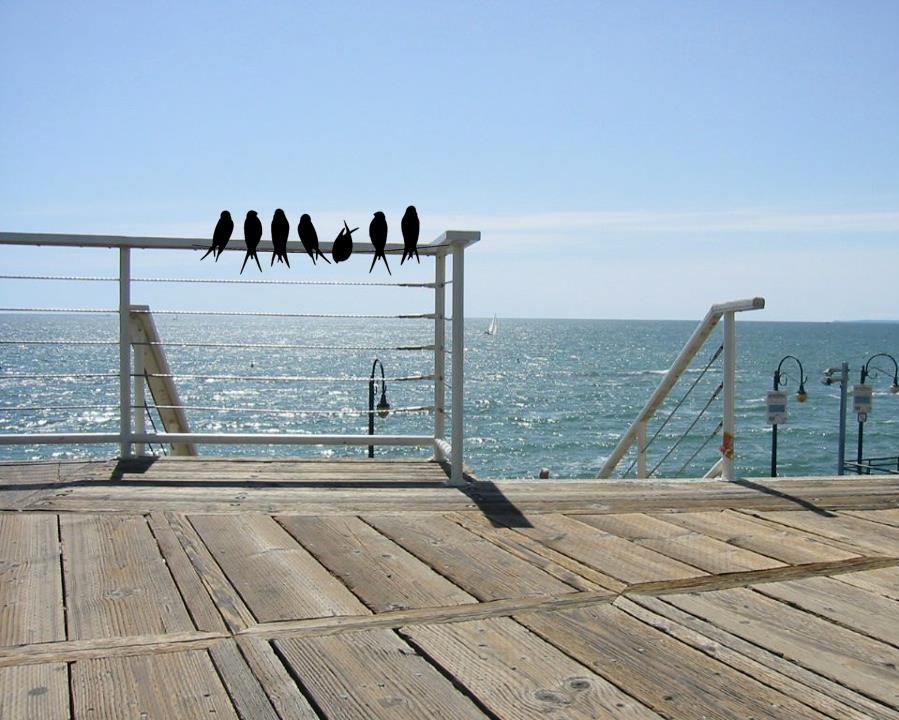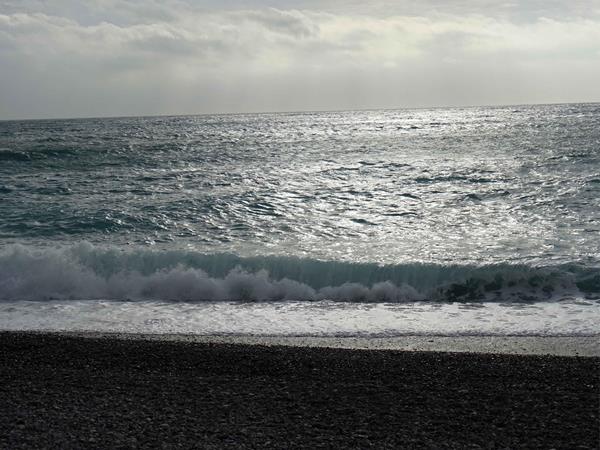Silence (34) - Tĩnh lặng (34). Mai Văn Phấn. Explicated by Dr. Ramesh Chandra Mukhopadhyaya - bình chú. Traduction française Dominique de Miscault – Dịch sang tiếng Pháp. Takya Đỗ dịch sang tiếng Việt
Silence (34) by Mai Văn Phấn
Explicated by Dr. Ramesh Chandra Mukhopadhyaya
Translated into French by Dominique de Miscault
Translated into Vietnamese by Takya Đỗ

Tác phẩm của Nghệ sỹ Dominique de Miscault
Silence
34
New day on the coast
The waves have receded
Leaving behind a clean
stone slab
Somebody has come to step
And sit on it
Bird feces
And dust settling on it
At night
Water rises again and
washes it
The sea
Is patient
In years.
(Translated from Vietnamese by Nhat-Lang Le & Susan Blanshard)
Explication
This is a
wonderful poem on the poets visiting a sea shore. Early in the morning the poet
is on his way to the sea shore. The poet is aware of the newness of the New
day. Every morning is a new birth. The poet is on his way to the seashore to
have a glimpse of the infinitude of the sea of pure consciousness roaring at
the borders of the landscape of the phenomenal world.
At the
sea shore in the morning the poet finds the sea receded away and there is
a stone slab. A man sits on it for a time. Bird feces and dust settle on it. In
the night the water rises again and crawls to the shore. It washes the stone
slab. This is dramatic. There is the unity of action. The sea recedes away. A
stone slab shows up. The stone slab becomes dirty with use. The sea rises again
and comes to the shore. It washes the stone slab. That is all. There is unity
of place. The action takes place at the sea shore only. There is the unity
of time. The action takes place within 24 hours. The poet himself functions as
chorus. The legitimation is simple. The sea is old in years. Hence
the sea is wise and patient.
In other
words the poet wants to draw our attention to the wisdom of the elemental
forces of Nature. They have been working since time immemorial and we must
learn patience from them. Dharma or a rule is immanent in Nature. Nature never deviates
from the same. Nature can cleanse itself on its own if it is left to
itself. But man now a days stand in the way of Nature. Dirty coasters carrying
the cargo of coal, tin, iron and other things pollute the ocean itself. So the
sea is no longer capable of washing the shores. But there seems to be a
warning. If Nature is not left to itself the sea might rise again and destroy
the human world just as it did in prehistoric age. The sea could stand for
mighty Time that mows down everything.
On
another level the stone slab could be the symbol of a person. During its
lifetime or during the day it is exposed to the world of senses. It becomes polluted
consequently. Thereafter death or the night comes. The sea inundates the stone
slab or the person. Next morning the stone slab or the person shows up or
is born again cleansed and with fresh energies. Thus with the poet death is
nothing to be feared. It only washes us of our crudities so that we are reborn
with fresh energies.
This is a
poem capable of meaning on many levels.
The landscape is the contingent world of senses.
But it is bordered by the boundless sea of consciousness. Waves
rushing up from there remind us that the phenomenal world is not all in all. The
poet stands at the sea shore to discover the truth. The poet plunged in
meditation now stands between the conscious mind and the unconsvious mind where
the pure consciousness roars. Waves from the sea of pure consciousness come
crawling towards him.
Explication par Dr. Ramesh Chandra Mukhopadhyaya
Traduction française Dominique de Miscault

Photo: Nhà thơ Nhà thơ-Giáo sư Jean-Michel Maulpoix, Pháp
Silence
34
Nouvelle journée sur le rivage
à marée basse
la dalle lisse, découverte
Quelqu'un, ici
est assis
excréments d'oiseaux
poussière déposée
La nuit l'eau remonte
balaye à nouveau
Mer
patiente
années après années
Explication
C'est un poème merveilleux,
de poètes au bord de la mer. Tôt le matin, le poète se dirige vers le rivage,
il est conscient du renouveau du jour. Chaque matin est une nouvelle naissance.
Le poète se dirige vers le rivage pour apercevoir l'infini de la mer de la
conscience pure rugissant aux confins du monde phénoménal.
Sur le rivage, le matin,
à marée basse, une dalle de pierre est découverte. Un homme y est assis. Des
excréments d'oiseaux et des poussières s'y sont déposés. Dans la nuit, la mer remonte
et de nouveau rampe vers le rivage. Elle lessive la dalle. C'est un drame : Unité d'action. La mer
recule, une dalle apparaît. La dalle est salie. La mer remonte sur le rivage.
Elle nettoie la dalle. C'est tout : Unité de lieu : Le rivage. Unité
du temps : en 24 heures. Le poète fonctionne comme le chœur. La légitimation est très simple. La mer est très
ancienne : Par conséquent, la mer est sage et patiente.
En d'autres termes, le
poète veut attirer notre attention sur la sagesse des forces élémentaires de la
nature. Elles travaillent depuis des temps immémoriaux et nous devons apprendre
de leur patience. Le Dharma est
immanent à la nature. La nature ne dévie jamais de son fonctionnement originel.
La nature peut se restaurer seule si elle est laissée à elle-même. Mais l'homme
aujourd’hui, dégrade la Nature. De sales caboteurs charriant des cargaisons de
charbon, d'étain, de fer et autres choses polluent l'océan. La mer n'est donc
plus capable de nettoyer ses rivages. C’est un avertissement. Si la nature
n'est pas respectée, la mer pourrait se réveiller et détruire le monde comme ce
fut le cas pendant la préhistoire. La mer a la puissance de survivre à toute
destruction dans le temps.
Sur un autre plan, la
dalle de pierre pourrait symboliser une personne. Au cours de sa vie ou pendant
la journée, il est exposé au monde des sens. Par conséquent il subit une
certaine pollution, ensuite, la mort ou la nuit viennent. La mer recouvre la
dalle ou la personne. Le lendemain matin, la dalle ou la personne
réapparaissent ou sont de nouveau nettoyées par de nouvelles énergies. Ainsi,
pour le poète, la mort n'est pas à craindre. Elle nous lave de nos aspérités
afin que nous renaissions avec de nouvelles énergies.
C'est un poème dont les
significations se trouvent à plusieurs niveaux.
Le paysage correspond au
monde des sens, bordé par la mer infinie de la conscience. Les vagues qui se
précipitent rappellent que le monde phénoménal n'est pas fini. Le poète se
tient au bord de la mer pour découvrir la vérité. Le poète plongé dans la
méditation se situe maintenant entre le conscient et l'inconscient où la pure
conscience gronde. Les vagues de la mer de la conscience pure rampent vers lui.
Dharma signifie « protection ». En pratiquant les
enseignements de Bouddha, nous nous protégeons contre la souffrance et les
problèmes. Toutes les difficultés rencontrées dans notre vie quotidienne ont
l’ignorance pour origine, et la méthode pour éliminer l’ignorance est la
pratique du dharma. Pratiquer le dharma est la méthode suprême pour améliorer
la qualité de notre vie humaine. La qualité de la vie ne dépend pas du
développement extérieur ou du progrès matériel, mais du développement intérieur
de la paix et du bonheur. Autrefois par exemple, de nombreux bouddhistes
vivaient dans des pays pauvres et sous-développés, mais ils ont pu trouver un
bonheur pur et durable en pratiquant ce que Bouddha a enseigné. Si nous
intégrons les enseignements de Bouddha dans notre vie de tous les jours, nous
pourrons résoudre tous nos problèmes intérieurs et avoir véritablement un
esprit en paix. Sans paix intérieure, la paix extérieure est impossible. Si
nous établissons d’abord la paix dans notre esprit en nous entraînant aux voies
spirituelles, la paix extérieure viendra naturellement, mais si nous ne le
faisons pas, le monde ne connaîtra jamais la paix, quel que soit le nombre de
personnes qui militent en sa faveur.
Tĩnh lặng (34) của Mai Văn Phấn
Ramesh Chandra Mukhopadhyaya bình chú
Dominique de Miscault dịch sang tiếng Pháp
Takya Đỗ dịch sang tiếng Việt
34
Ngày mới ven biển
Sóng rút đi
Để lại phiến đá sạch
Ai đến ngồi
Bước lên
Cùng phân chim
Cát bụi tấp vào
Đêm về
Nước lại dâng lên rửa sạch
Biển
Nhẫn nại như vậy
Nhiều năm.
Bình chú:
Đây là bài thơ hay
lạ lùng về chuyến dạo chơi bờ biển của nhà thơ. Sáng sớm mai nhà thơ đang trên
đường ra bờ biển. Nhà thơ nhận thấy sự tinh khôi của một Ngày mới. Mỗi buổi ban
mai đều mới được sinh ra. Nhà thơ trên đường ra bờ biển để chiêm ngưỡng sự vô
tận của đại dương ý thức thuần khiết ầm ào sóng vỗ bên rìa khung cảnh thế giới
hiện tượng.
Sớm mai trên bờ biển nhà thơ thấy sóng biển
rút ra xa và một phiến đá nằm ở đó. Có người ngồi trên đó một lúc. Phân chim và
cát bụi tấp vào mặt phiến đá. Đêm đến thủy triều dâng lên và trườn vào bờ. Sóng
rửa sạch phiến đá ấy. Thật ấn tượng. Ở đó có sự hợp nhất về hành động. Biển rút
ra xa. Một phiến đá lộ ra. Phiến đá ấy
bị dùng đến vấy bẩn. Biển lại dâng lên và vào đến tận bờ. Nó rửa sạch phiến đá.
Thế thôi. Ở đó có sự hợp nhất về địa điểm. Hành động chỉ xảy ra tại bờ biển ấy
thôi. Ở đó có sự hợp nhất về thời gian. Hành động xảy ra trong vòng 24 giờ đồng
hồ. Nhà thơ tự mình đóng vai người dẫn giải các sự việc. Ý nghĩa thật đơn giản.
Biển đã già đi theo năm tháng, thế nên biển thông tuệ và nhẫn nại.
Nói cách khác, nhà thơ muốn hướng sự chú ý
của chúng ta vào sự thông thái của các lực căn bản của Tự nhiên. Chúng vẫn
không ngừng hoạt động từ thượng cổ tới nay và chúng ta phải học tính nhẫn nại
của chúng. Pháp [Dharma] hay phép tắc
quy luật vốn dĩ sẵn có trong Tự nhiên. Tự nhiên chẳng khi nào xa rời khỏi Pháp.
Tự nhiên có thể tự gột rửa cho mình sạch tinh nếu nó được để yên không động
chạm. Nhưng ngày nay con người thường can thiệp vào Tự nhiên. Những bãi biển
rác rưởi đầy những con tàu chở than, thiếc, sắt và những thứ làm ô nhiễm đại
dương. Nên biển cả đã không còn có thể rửa sạch bến bờ của nó nữa. Nhưng dường
như đó là lời cảnh báo. Nếu Tự nhiên không được để yên thì biển cả có ngày sẽ
lại trào dâng lần nữa và hủy hoại thế giới của con người như nó đã từng làm thế
từ thời tiền sử. Biển cả có thể biểu trưng cho Thời gian đầy quyền năng đang
tàn sát tất thảy mọi thứ.
Mặt khác, phiến đá có thể tượng trưng cho một
người. Trong suốt cuộc đời của nó hoặc trong cái ngày mà nó phô mình ra trước
thế giới tri giác. Kết cục nó bị vấy bẩn. Sau đó cái chết hoặc bóng đêm sẽ đến.
Biển cả phủ sóng lên phiến đá hay con người đó. Sáng hôm sau phiến đá hay con
người ấy xuất hiện hay được sinh ra thêm lần nữa sạch sẽ tinh khôi và tràn trề sức
sống mới. Như vậy đối với nhà thơ, cái chết chẳng có gì đáng sợ. Cái chết chỉ
gột rửa cho chúng ta sạch làu man rợ để chúng ta tái sinh với sức sống mới.
Đây là một bài thơ có ý nghĩa về nhiều mặt.
Khung
cảnh ấy là thế giới tri giác ngẫu nhiên. Nhưng nó tiếp giáp với đại dương nhận
thức bao la vô tận. Những làn sóng xô bờ nhắc ta nhớ rằng thế giới hiện tượng
không phải là tất cả. Nhà thơ đứng ở bờ biển để tìm ra chân lý. Nhà thơ chìm
vào quán tưởng lúc này đang đứng giữa tâm thức và tâm vô thức, nơi ý thức thuần
khiết đang ầm ào sóng vỗ. Những làn sóng từ đại dương ý thức thuần khiết đang
trườn về phía ông.

Ts. Ramesh Chandra Mukhopadhyaya
Dr. Ramesh Chandra Mukhopadhyaya
Address: 6/ 1 Amrita Lal Nath lane P.0. Belur Math Dist Howrah West Bengal India Pin code711202. Date of Birth 11 02 1947. Education M.A [ triple] M Phil Ph D Sutrapitaka tirtha plus degree in homeopathy. He remains a retired teacher of B.B. College, Asansol, India. He has published books in different academic fields including religion, sociology, literature, economics, politics and so on. Most of his books have been written in vernacular i.e. Bengali. Was awarded gold medal by the University of Calcutta for studies in modern Bengali drama.
TS. Ramesh Chandra Mukhopadhyaya
Địa chỉ: 6/ 1 đường Amrita Lal Nath hòm thư Belur Math Dist Howrah Tây Bengal Ấn Độ mã số 711202. Ngày sinh: 11 02 1947. Thạc sĩ văn chương, thạc sĩ triết học, tiến sĩ triết học [bộ ba] cùng với Bằng y học về phép chữa vi lượng đồng cân. Ông còn là một giảng viên đã nghỉ hưu của Trường đại học B.B, Asansol, Ấn Độ. Ông đã có những cuốn sách được xuất bản về nhiều lĩnh vực học thuật bao gồm tôn giáo, xã hội học, văn học, kinh tế, chính trị v.v. Hầu hết sách của ông đã được viết bằng tiếng bản địa là tiếng Bengal. Ông đã được tặng thưởng huy chương vàng của Trường đại học Calcutta về các nghiên cứu nghệ thuật sân khấu Bengal hiện đại.

Nhà thơ - Nghệ sỹ Dominique de Miscault
Poétesse - Artiste Dominique de Miscault
Artiste Plasticienne. Actualités. De plages en pages qui se tournent. C’était hier, de 1967 à 1980, mais aussi avant hier. puis de 1981 à 1992. Et encore de 1992 à 2012 bien au delà des frontières. Aujourd’hui, la plage est blanche sous le bleu du soleil. Ecrire en images, cacher les mots porteurs de souffrance ; on ne raconte pas les pas d’une vie qui commence en 1947. C’est en 1969 que j’ai été invitée à exposer pour la première fois. Depuis j’ai eu l’occasion de « vagabonder » seule ou en groupe en France et dans le monde sûrement près de 300 fois. Les matériaux légers sont mes supports, ceux du voyage et de l’oubli.
www.dominiquedemiscault.fr
www.dominiquedemiscault.com
www.aleksander-lobanov.com
Nhà thơ - Nghệ sỹ Dominique de Miscault
Nghệ sĩ nghệ thuật thị giác đương đại. Từ bãi biển đến trang giấy. Là ngày hôm qua, từ 1967 đến 1980, và trước đó, rồi từ 1981 đến 1992. Và nữa từ 1992 đến 2012 trên tất cả các biên giới. Ngày hôm nay là bãi biển trắng dưới bầu trời xanh. Viết bằng hình ảnh, giấu từ ngữ mang nỗi đau, người ta không kể lại những bước đi trong cuộc đời tính từ năm 1947. Vào năm 1969, lần đầu tiên tôi được mời triển lãm tác phẩm. Kể từ đó, tôi có cơ hội một mình "lang bạt" hoặc theo nhóm ở nước Pháp và khắp nơi trên thế giới, chắc chắn gần 300 lần. Những chất liệu nhẹ là nguồn hỗ trợ tôi, những chất liệu của hành trình và quên lãng.
www.dominiquedemiscault.fr
www.dominiquedemiscault.com
www.aleksander-lobanov.com
Tĩnh lặng - Silence (1)
Tĩnh lặng - Silence (2)
Tĩnh lặng - Silence (3)
Tĩnh lặng - Silence (4)
Tĩnh lặng - Silence (5)
Tĩnh lặng - Silence (6)
Tĩnh lặng - Silence (7)
Tĩnh lặng - Silence (8)
Tĩnh lặng - Silence (9)
Tĩnh lặng - Silence (10)
Tĩnh lặng - Silence (11)
Tĩnh lặng - Silence (12)
Tĩnh lặng - Silence (13)
Tĩnh lặng - Silence (14)
Tĩnh lặng - Silence (15)
Tĩnh lặng - Silence (16)
Tĩnh lặng - Silence (17)
Tĩnh lặng - Silence (18)
Tĩnh lặng - Silence (19)
Tĩnh lặng - Silence (20)
Tĩnh lặng - Silence (21)
Tĩnh lặng - Silence (22)
Tĩnh lặng - Silence (23)
Tĩnh lặng - Silence (24)
Tĩnh lặng - Silence (25)
Tĩnh lặng - Silence (26)
Tĩnh lặng - Silence (27)
Tĩnh lặng - Silence (28)
Tĩnh lặng - Silence (29)
Tĩnh lặng - Silence (30)
Tĩnh lặng - Silence (31)
Tĩnh lặng - Silence (32)
Tĩnh lặng - Silence (33)

Photo: Nghệ sỹ Dominique de Miscault